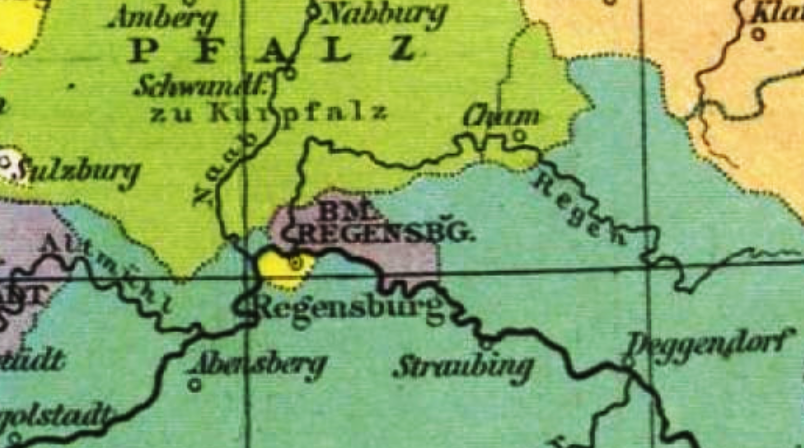Bishopric of Regensburg on:
[Wikipedia]
[Google]
[Amazon]
The Prince-Bishopric of Regensburg (german: link=no, Fürstbistum Regensburg; Hochstift Regensburg) was a small ecclesiastical principality of the
 The diocese was founded in 739 by Saint Boniface; it was originally subordinate to the
The diocese was founded in 739 by Saint Boniface; it was originally subordinate to the
Official website
{{DEFAULTSORT:Regensburg, Bishopric Prince-bishoprics of the Holy Roman Empire in Germany Roman Catholic dioceses in the Holy Roman Empire 739 establishments Dioceses established in the 8th century 13th-century establishments in the Holy Roman Empire 1803 disestablishments in the Holy Roman Empire States and territories established in the 13th century Bavarian Circle Regensburg it:Diocesi di Ratisbona la:Dioecesis Ratisbonensis no:Regensburg bispedømme
Holy Roman Empire
The Holy Roman Empire was a political entity in Western, Central, and Southern Europe that developed during the Early Middle Ages and continued until its dissolution in 1806 during the Napoleonic Wars.
From the accession of Otto I in 962 ...
located near the Free Imperial City of Regensburg in Bavaria. It was elevated to the Archbishopric of Regensburg in 1803 after the dissolution of the Archbishopric of Mainz. The Prince-Bishopric of Regensburg must not be confused with the Roman Catholic Diocese of Regensburg
The Diocese of Regensburg ( la, Dioecesis Ratisbonensis) is a Roman Catholic ecclesiastical territory seated in Regensburg, Germany. Its district covers parts of northeastern Bavaria; it is subordinate to the archbishop of Munich and Freising. , ...
, which was considerably larger.
History
 The diocese was founded in 739 by Saint Boniface; it was originally subordinate to the
The diocese was founded in 739 by Saint Boniface; it was originally subordinate to the archbishop of Salzburg
The Roman Catholic Archdiocese of Salzburg ( la, Archidioecesis Salisburgensis) is an archdiocese of the Latin Rite of the Roman Catholic Church in Austria. The archdiocese is one of two Austrian archdioceses, serving alongside the Archdiocese ...
. In the 13th century, the bishop of Regensburg became a prince of the Holy Roman Empire
The Holy Roman Empire was a political entity in Western, Central, and Southern Europe that developed during the Early Middle Ages and continued until its dissolution in 1806 during the Napoleonic Wars.
From the accession of Otto I in 962 ...
with a seat and vote at the Imperial Diet. As an enclave of the Duchy of Bavaria
The Duchy of Bavaria ( German: ''Herzogtum Bayern'') was a frontier region in the southeastern part of the Merovingian kingdom from the sixth through the eighth century. It was settled by Bavarian tribes and ruled by dukes (''duces'') under ...
, the prince-bishopric was not able to expand territorially and remained one of the smallest of the Empire.
In the course of the German mediatization of 1803, the prince-bishopric was united with the Free Imperial city of Regensburg and other territories to form the Principality of Regensburg. Karl Theodor Anton Maria von Dalberg
Karl Theodor Anton Maria von Dalberg (8 February 1744 – 10 February 1817) was Prince- Archbishop of Regensburg, Arch-Chancellor of the Holy Roman Empire, Bishop of Constance and Worms, prince-primate of the Confederation of the Rhine and Gr ...
was the first prince-archbishop. In 1810, the pincipality became part of the Kingdom of Bavaria
The Kingdom of Bavaria (german: Königreich Bayern; ; spelled ''Baiern'' until 1825) was a German state that succeeded the former Electorate of Bavaria in 1805 and continued to exist until 1918. With the unification of Germany into the German ...
, although it retained archiepiscopal status. This followed the fall of the Holy Roman Empire in 1806 during the War of the Third Coalition
The War of the Third Coalition)
* In French historiography, it is known as the Austrian campaign of 1805 (french: Campagne d'Autriche de 1805) or the German campaign of 1805 (french: Campagne d'Allemagne de 1805) was a European conflict spanni ...
.
The Bavarian Concordat of 1817 following Dalberg's death downgraded the Archdiocese of Regensburg into a suffragan diocese subordinate to the archbishop of Munich and Freising
The following people were bishops, prince-bishops or archbishops of Freising or Munich and Freising in Bavaria:
Bishops of Freising
* St. Corbinian (724–730); founded the Benedictine abbey in Freising, although the diocese was not orga ...
.
Famous prince-bishops
* Saint Wolfgang (972–994) * SaintAlbertus Magnus
Albertus Magnus (c. 1200 – 15 November 1280), also known as Saint Albert the Great or Albert of Cologne, was a German Dominican friar, philosopher, scientist, and bishop. Later canonised as a Catholic saint, he was known during his li ...
(1260–1262)
* Joseph Clemens of Bavaria
Joseph Clemens of Bavaria (german: Joseph Clemens von Bayern) (5 December 1671 – 12 November 1723) was a member of the Wittelsbach dynasty of Bavaria and Archbishop-Elector of Cologne from 1688 to 1723.
Biography
The third son of Ferdinand ...
(1685–1716)
* Clemens August of Bavaria
Clemens August of Bavaria (german: Clemens August von Bayern) (17 August 1700 – 6 February 1761) was a member of the Wittelsbach dynasty of Bavaria and Archbishop-Elector of Cologne.
Biography
Clemens August (Clementus Augustus) was born in ...
(1716–1719)
See also
*Roman Catholic Diocese of Regensburg
The Diocese of Regensburg ( la, Dioecesis Ratisbonensis) is a Roman Catholic ecclesiastical territory seated in Regensburg, Germany. Its district covers parts of northeastern Bavaria; it is subordinate to the archbishop of Munich and Freising. , ...
Further reading
*Josef Staber: ''Kirchengeschichte des Bistums Regensburg''. Regensburg 1966 (in German)External links
Official website
{{DEFAULTSORT:Regensburg, Bishopric Prince-bishoprics of the Holy Roman Empire in Germany Roman Catholic dioceses in the Holy Roman Empire 739 establishments Dioceses established in the 8th century 13th-century establishments in the Holy Roman Empire 1803 disestablishments in the Holy Roman Empire States and territories established in the 13th century Bavarian Circle Regensburg it:Diocesi di Ratisbona la:Dioecesis Ratisbonensis no:Regensburg bispedømme